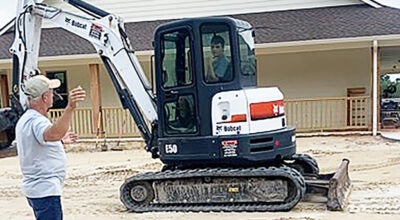What Made Orange Great: Levingston Shipyard: The most versatile of the Orange shipyards
Published 7:50 am Wednesday, November 17, 2021
|
Getting your Trinity Audio player ready...
|
By Mike Louviere
Samuel Hiram Levingston was born in Ireland in 1832. At the age of 14, he and his brothers, David and John, and sister Margaret left their home in Northern Ireland and migrated to America. They settled in Apalachicola, Florida, where Samuel learned to be a ship carpenter.
In 1852, at the age of 20, he married Asenatha Moore. By 1859, the couple had moved to Orange, Texas, started a small shipyard and were building paddle wheel steamboats for service on the Sabine River.
Levingston served with the Confederate Forces during the Civil War, building ships and running the Union blockade.
Records taken from his Confederate Pension Application show that he enlisted in March 1861 and served “Honorably” as a private in Merriman’s Orange County “Coast Guard”, “Local Defense Troops”, and on “C.S.S. Cotton Clad Confederate Paddle Wheel Gunboats”. He was sent to New Orleans and helped build the C.S.A. Gunboat “Mississippi”. He went other places for special duty as a “Ship’s Carpenter” and was “Honorably Discharged” in June 1865 with the disbanding of the “Marine Department of Texas.” He was granted a Confederate Pension by the State of Texas for his service.
After the war, he returned to Orange and began another shipyard building paddle wheel for use in the cotton and farm products trade between Orange and Logansport, Louisiana. When he retired, his son “Captain George” Levingston took over the business. Samuel died in 1911 and is buried alongside his wife in Evergreen Cemetery in Orange.
“Captain George” as he was popularly known made changes in the business and developed it into the Levingston Shipbuilding Company in 1919-1920.
In 1930, Levingston bought five acres at Mill and Front streets and expanded the business from its original location near the foot of Moss Street. Levingston Shipbuilding would continue operations at the Mill and Front Street location for the remainder of its existence.
Levingston survived the depression years of the 1930s by incorporating. In 1939, Edward T. Malloy was hired as general manager and stayed with the company eventually buying controlling interest in 1945.
World War II brought an increase in shipbuilding to Orange. Congressman Martin Dies had been instrumental in bringing a major contract to the nearby shipyard, Consolidated Steel, to build destroyers for the U.S. Navy. Levingston obtained contracts to also build for the Navy. They would focus on tugboats and other auxiliary vessels.
Levingston’s first contract was for the 530 ton steel hulled tugboat, “Tuscarora.” She was launched on December 13, 1941. Between 1941 and 1945, Levingston would build and launch a total of 160 vessels for the U.S. Navy and U.S. Army. The vessels included tugs, tankers, barges, and ocean going rescue vessels. Some of the rescue vessels were built for the British Navy. Levingston built more tugboats for the war effort than any other shipyard in World War II.
In recognition for the work Levingston was doing the shipyard received the coveted “E” Award that was given for outstanding contribution to war production.
After the end of World War II, Levingston changed with the economic times and became a worldwide leader in the design, engineering, and construction of off-shore drilling rigs, jack-up platforms, and self-propelled drilling ships.
The company had bought an island across the river from the shipyard to expand its operations. The island had been created by the dredging of a channel across a narrow peninsula created by the horseshoe bend in the river. The channel made it possible for ships to go upriver past Orange without having to negotiate the sharp bend at Orange. The island is known as “Levingston Island”.
A Levingston employee working on the Orange side of the river was a Texas employee. An employee working on “the Island” was actually working in Louisiana. The fact that the channel had been dug and changed navigation did not change the fact that Levingston Island is located in Louisiana. The state line followed the original river channel. Levingston employees working on the Island had to pay Louisiana Income Tax. Those on the Texas side did not, possibly that was a bookkeeper’s headache.
Orange residents in 1964 and 1965 were able to glimpse some unique construction on Levingston Island. The shipyard had the contract to build three ferry boats for service at Staten Island, New York.
The ferry boats would be 297 feet long, 69 feet 10 inches wide. They would have a draft of 13 feet, 6 inches, weigh 2, 109 tons, and be capable of a speed of 16 knots, or 30 miles an hour. The power plant would be diesel engines capable of producing 6,500 horsepower.
The vessels were: the M.V. John F. Kennedy, M.V. American Legion, and the M.V. Herbert H. Lehman. They would be known as the “Kennedy Class.”
The American Legion remained in service for 40 years, until replaced by a newer class ferry. The Herbert H. Lehman retired June 30, 2007. The John F. Kennedy remains in service as a reserve ferry.
Growth had continued and in addition to construction there had also been a part of the business dedicated to the repair of offshore drilling rigs. When the bridge was built to Pleasure Island in Port Arthur offshore rigs were no longer able to be brought to Orange. Levingston acquired Gulfport Shipbuilding on the downstream side of the bridge in Port Arthur to use as the facility for rig repair.
Levingston remained privately owned until 1977 when it was sold to Ashland Oil. During the Ashland years, in 1981, one of Levingston’s largest vessels was launched, the bulk carrier “Pride of Texas.”
The ship was 611 feet long and was 36,000 tons. She would be able to carry 23,500 tons of cargo at a speed of 15.7 knots. There would be three ships built in this class, the Pride of Texas, Spirit of Texas, and Star of Texas.
In spite of Levingston’s ability to build anything the marine or oil industry required, economics took its toll on the shipyard. Ed Paden, the president of Ashland Oil, bought the shipyard in 1982 and began phasing the company out of existence. Levingston closed in 1985 and with it a long and proud history of 126 years of shipbuilding in Orange ended.
Paul A. Mattingly, Jr. came to Orange at the beginning of World War II. His father became the CFO for Levingston for the next 12 years. Paul Jr. always felt a close connection to the Levingston shipyard “family.” He decided to document the legacy of the shipyard on the river in Orange.
Mattingly, Jr.’s book From Orange to Singapore says that “Levingston Shipbuilding in Orange employed a group of workers who with their ‘can-do’ spirit forged the company forward as pioneers in shipbuilding technology, offshore drilling, and ocean exploration.
From the building of the ‘Kennedy Class” ferries for Staten Island, the New York harbor tugs for Moran Towing, the Glomar Challenger ( a drillship built for Howard Hughes), to the current connection to Keppel FELS (Far East Levingston Shipbuilding), the largest builder of jack up drilling rigs in the world, the legacy of the little shipyard in Orange, Texas continues.”
Orange Shipbuilding is keeping the shipbuilding tradition alive in Orange today at about the same place Samuel Levingston built his first paddlewheel boat. The small yard has even built a ferry to be used in North Carolina in the shadow of the long gone orange and blue ferries that went to Staten Island. Orange Shipbuilding also builds tugboats. It’s good to see that even though things have changed, some things are still familiar on the river.






